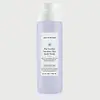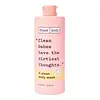What's inside
What's inside
 Key Ingredients
Key Ingredients

 Benefits
Benefits

 Concerns
Concerns

No concerns
 Ingredients Side-by-side
Ingredients Side-by-side

Water
Skin ConditioningSodium Cocoyl Isethionate
CleansingHydroxypropyl Starch Phosphate
Cocamidopropyl Hydroxysultaine
CleansingGlycerin
HumectantCoco-Glucoside
CleansingSodium Methyl Cocoyl Taurate
CleansingAvena Sativa Kernel Flour
AbrasiveAloe Barbadensis Leaf Juice
Skin ConditioningCalendula Officinalis Flower Extract
MaskingPanthenyl Hydroxypropyl Steardimonium Chloride
Chamomilla Recutita Flower Extract
MaskingGlycol Distearate
EmollientAlthaea Officinalis Root Extract
Skin ConditioningCamellia Sinensis Seed Extract
HumectantPhenoxyethanol
PreservativeCocamide Mipa
EmulsifyingEthylhexylglycerin
Skin ConditioningTetrasodium Glutamate Diacetate
Saccharomyces Ferment Lysate Filtrate
Skin ConditioningCitric Acid
BufferingWater, Sodium Cocoyl Isethionate, Hydroxypropyl Starch Phosphate, Cocamidopropyl Hydroxysultaine, Glycerin, Coco-Glucoside, Sodium Methyl Cocoyl Taurate, Avena Sativa Kernel Flour, Aloe Barbadensis Leaf Juice, Calendula Officinalis Flower Extract, Panthenyl Hydroxypropyl Steardimonium Chloride, Chamomilla Recutita Flower Extract, Glycol Distearate, Althaea Officinalis Root Extract, Camellia Sinensis Seed Extract, Phenoxyethanol, Cocamide Mipa, Ethylhexylglycerin, Tetrasodium Glutamate Diacetate, Saccharomyces Ferment Lysate Filtrate, Citric Acid
Water
Skin ConditioningCocamidopropyl Betaine
CleansingAloe Barbadensis Leaf Extract
EmollientMyristamide Dipa
CleansingSodium Lauroyl Sarcosinate
CleansingCoffea Robusta Seed Extract
Skin ConditioningPunica Granatum Fruit Extract
AntioxidantTerminalia Ferdinandiana Fruit Extract
AntioxidantDecyl Glucoside
CleansingPanthenol
Skin ConditioningGlycerin
HumectantSodium Cocoamphoacetate
CleansingSodium Cocoyl Glutamate
CleansingAcrylates/C10-30 Alkyl Acrylate Crosspolymer
Emulsion StabilisingParfum
MaskingPotassium Sorbate
PreservativePhenoxyethanol
PreservativeTriethanolamine
BufferingWater, Cocamidopropyl Betaine, Aloe Barbadensis Leaf Extract, Myristamide Dipa, Sodium Lauroyl Sarcosinate, Coffea Robusta Seed Extract, Punica Granatum Fruit Extract, Terminalia Ferdinandiana Fruit Extract, Decyl Glucoside, Panthenol, Glycerin, Sodium Cocoamphoacetate, Sodium Cocoyl Glutamate, Acrylates/C10-30 Alkyl Acrylate Crosspolymer, Parfum, Potassium Sorbate, Phenoxyethanol, Triethanolamine
 Reviews
Reviews

Ingredients Explained
These ingredients are found in both products.
Ingredients higher up in an ingredient list are typically present in a larger amount.
Glycerin is already naturally found in your skin. It helps moisturize and protect your skin.
A study from 2016 found glycerin to be more effective as a humectant than AHAs and hyaluronic acid.
As a humectant, it helps the skin stay hydrated by pulling moisture to your skin. The low molecular weight of glycerin allows it to pull moisture into the deeper layers of your skin.
Hydrated skin improves your skin barrier; Your skin barrier helps protect against irritants and bacteria.
Glycerin has also been found to have antimicrobial and antiviral properties. Due to these properties, glycerin is often used in wound and burn treatments.
In cosmetics, glycerin is usually derived from plants such as soybean or palm. However, it can also be sourced from animals, such as tallow or animal fat.
This ingredient is organic, colorless, odorless, and non-toxic.
Glycerin is the name for this ingredient in American English. British English uses Glycerol/Glycerine.
Learn more about GlycerinPhenoxyethanol is a preservative that has germicide, antimicrobial, and aromatic properties. Studies show that phenoxyethanol can prevent microbial growth. By itself, it has a scent that is similar to that of a rose.
It's often used in formulations along with Caprylyl Glycol to preserve the shelf life of products.
Water. It's the most common cosmetic ingredient of all. You'll usually see it at the top of ingredient lists, meaning that it makes up the largest part of the product.
So why is it so popular? Water most often acts as a solvent - this means that it helps dissolve other ingredients into the formulation.
You'll also recognize water as that liquid we all need to stay alive. If you see this, drink a glass of water. Stay hydrated!
Learn more about Water